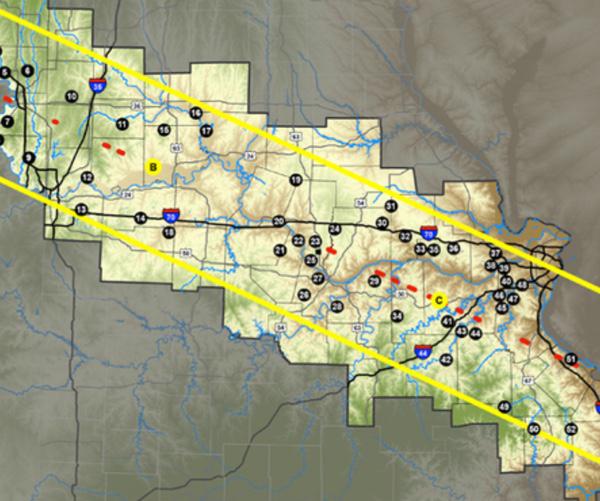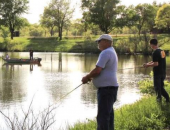Local News
Watch Solar Eclipse in Nature at MDC Areas
July 26th 2017 by Dee Loflin

Watch solar eclipse in nature at MDC areas
See how nature reacts by watching at 54 MDC areas in prime path of Aug. 21 event.
By Eleanor C. Hasenbeck, Missouri Department of Conservation
JEFFERSON CITY, Mo. -- Discover some unique activities in nature during the upcoming total solar eclipse on Aug. 21 by watching the rare event at one of 54 Missouri Department of Conservation (MDC) areas that lie in the solar eclipse’s primary path across Missouri.
During the eclipse, visitors at these conservation areas can enjoy regular outdoor activities -- such as fishing, hiking, and wildlife watching – in a far-from-regular way for a few minutes when the moon passes in front of the sun. The eclipse will also bring a rare chance for those watching wildlife to catch out-of-the-ordinary behaviors.
“Daylight is a cue for birds throughout their day to wake up in the morning and return to roost at night,” said MDC State Ornithologist Sarah Kendrick. “As the sky becomes darker during the eclipse, some birds may become confused by the lack of light and could exhibit odd behaviors such as going quiet, thinking that night is falling.”
Many of the featured MDC areas also offer an escape from crowded cities and light pollution, and all of the recommended areas have restrooms for visitor convenience.
While all areas are free to access and open to the public, some may require visitors to obtain a special-use permit for group camping.
Don’t forget to bring solar-eclipse-approved glasses for viewing the event!
For many Missourians, this total solar eclipse will be a once-in-a-lifetime event. The last total eclipse visible in the Show-Me State occurred in 1869. The next total solar eclipse will only be visible in parts of southern Missouri and will occur in April 2024.
According to NASA, during a total eclipse, the moon passes between the sun and the earth, blocking its light and allowing viewers to see the sun’s outer atmosphere, the corona. The moon casts a shadow, called an umbra, onto the earth. Communities in the path of totality will experience a few minutes of temperature drop and dimmed sunlight similar to twilight as the umbra passes over them.
Communities will experience totality at different times as the moon moves across the sky, but the first Missourians to see it will be those in St. Joseph around 1:04 p.m. The umbra will then cross central Missouri before totality occurs near Cape Girardeau around 1:20 p.m.
For an interactive map of the eclipse’s path across Missouri, approximate times to watch, a full list of recommended conservation areas for viewing, and details on each area, visit the MDC website at mdc.mo.gov/eclipse. A printable map is also available at the bottom of the webpage.
Last Updated on July 26th 2017 by Dee Loflin
https://showmetimes.com/Blogpost/v7v9/Watch-Solar-Eclipse-in-Nature-at-MDC-Areas
Stoddard County Route KK Closed for Pavement Repairs
July 24th 2017 by Dee Loflin

Stoddard County Route KK Closed for Pavement Repairs
Route KK in Stoddard County will be closed as Missouri Department of Transportation crews perform pavement repairs.
This section of roadway is located from Route 114 to County Road 732.
Weather permitting, work will take place Monday, July 24 through Thursday, Aug. 3 from 6:30 a.m. to 4:30 p.m. daily. The work zone will be open to local traffic only.
The work zone will be marked with signs. Motorists are urged to use extreme caution while traveling near the area.
For additional information, contact MoDOT’s Customer Service Center toll-free at 1-888-ASK-MODOT (1-888-275-6636) or visit www.modot.org/southeast.
Last Updated on July 24th 2017 by Frank M. Kromann
https://showmetimes.com/Blogpost/v7ur/Stoddard-County-Route-KK-Closed-for-Pavement-Repairs
Stoddard County Route F Closed for Pavement Repairs
July 24th 2017 by Dee Loflin

Stoddard County Route F Closed for Pavement Repairs
Route F in Stoddard County will be closed as Missouri Department of Transportation crews perform pavement repairs.
This section of roadway is located from Route 60 to Route J.
Weather permitting, work will take place Monday, July 24 through Wednesday, July 26 from 7 a.m. to 4:30 p.m. daily. The work zone will be open to local traffic only.
The work zone will be marked with signs. Motorists are urged to use extreme caution while traveling near the area.
For additional information, contact MoDOT’s Customer Service Center toll-free at 1-888-ASK-MODOT (1-888-275-6636) or visit www.modot.org/southeast.
Last Updated on July 24th 2017 by Dee Loflin
https://showmetimes.com/Blogpost/v7uq/Stoddard-County-Route-F-Closed-for-Pavement-Repairs
Did You Feel the Earthquake?
July 21st 2017 by Dee Loflin

New Madrid, Missouri - An earthquake shook a few places in and around New Madrid around 12:30 p.m. on Friday, July 21, 2017.
According to the U.S. Geological Survey, the 2.9 magnitude quake hit right along the Missouri-Tennessee border less than a half mile from Point Pleasant in New Madrid County.
There are no reports of damage associated with this quake.
Last Updated on July 21st 2017 by Dee Loflin
https://showmetimes.com/Blogpost/v7ui/Did-You-Feel-the-Earthquake
Do You Love Archery, Shooting, and Working with Youth?
July 21st 2017 by Dee Loflin

Do you love archery, muzzle loading, shotguns, pistols or rifles and working with youth?
If so, 4-H is the place for you! 4-H is looking for volunteers to expand our shooting sports project in the area.
This would consist of meeting with youth at least once a month for a minimum of one hour each month.
Hours are very flexible since you can set the schedule yourself! The next 4-H Shooting Sports Certification Workshop is October 6th - 8th in Fredericktown, MO.
The cost is $90 and this includes 5 meals, lodging, and workshop materials, but there is a grant to reimburse costs after the training.
The deadline for registration is August 1, but classes fill up fast so don’t delay!
If you are interested or would like more information please contact Stephanie Milner, 4-H Youth Specialist at 573-686-8064.
Last Updated on July 21st 2017 by Dee Loflin
https://showmetimes.com/Blogpost/v7u9/Do-You-Love-Archery-Shooting-and-Working-with-Youth














